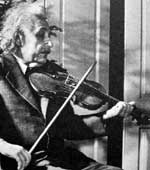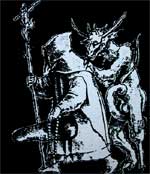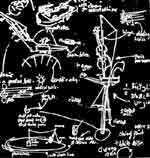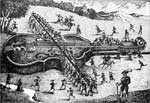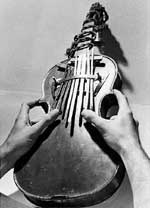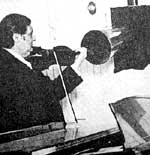 | |||||||

|
A FEW THOUGHTS ON THE LANGUAGE OF IMPROVISATION a little piece designed to spark up a few neurons |
|
Most books and films on Jazz finish around 40 years ago with the arrival of Free Jazz, heralded by the likes of Ornette Coleman, Cecil Taylor, Albert Ayler and John Coltrane - as one critic put it When Trane lost it and went too far out. Jazz educators like David Baker and young classically trained players like Winton Marsalis constantly point out that the history of jazz is over and now it is a question of performing the repertoire. They are probably correct, Jazz has parted from the necessary development and renewal only available through an aural tradition and has become reliant for its existence, like classical music, on academic study. The history of Improvisation however is something other than jazz and has not run into a dead end. In fact since Free Jazz, the practice of improvisation (free or otherwise) has exploded into a myriad of styles and languages. A veritable Tower of Babel. Improvising musicians talk about language and vocabulary in the context of musical style. The old axiom about music starting where language stops can easily put a stop to debate and understanding about the processes going on; a reluctance to debate doesn't help in trying to understand the wealth of differences in sonic material generated by the contemporary improviser. In any discussion of music as language, there are a number of issues that can be taken as general context, common notions within which all music operates - although applying universals to styles of music is often too simplistic. Starting at the deep end, what is music anyway? To keep every one happy, let's just say it is sound with intent. Intent: that if I rub these two stones together, or scratch an LP with the stylus and the volume turned up to howling feedback, it is music; that if I sit and listen to two Butcher Birds singing together, or to jet planes taking off from an airport for 5 hours, my intention is to hear the experience as music. The same for the more traditional action of playing or listening to a violin. As you can hear from the embedded sound on this page, the venerable Dr. R. Wang from Hong Kong University has no doubts about the use of music in linguistic training. However academics working in either music or language would probably have a few doubts about the methodology of the good doctor! (I think it's wild entertainment). As to difference in comprehension of speech or music - try listening to what the good doctor is saying while reading this text. Then try listening to what the good doctor is playing on the violin while reading this text. Is there a difference in the way that the brain deals with these problems? Ethnomusicologists have shown us that in many traditional cultures no word for what we pronounce as music actually exists. Most evidence over the last 10,000 years from communities and smaller social groups shows that music was performed to support a function; no function, no music.. It was an aid to hunting, story telling, shepherding, war, religion and accompanied every aspect of life from birth, through marriage to the grave. This is clearly not the case today. There is little left in the way of common social experience that is celebrated with live music, crowd vocalisation at football matches spring to mind as one exception. Music exists now mostly as a playback experience with little personal investment of time, preparation and energy. The notion of music as pure entertainment is a comparatively recent phenomena in the time table of human evolution. Talking of evolution. The study of language evolution must inevitably look to music as both forms needed the development of the vocal tract , symbolic gesture, syntax and a large brain for rapid cognitive processing. The various ologists are still fighting about which came first, the conscious music making or the aural invitation Hey Betty (Flintstone), would you like the next dance? Steven Mithen in his book 'The Singing Neanderthals', is convinced that music came first - that holistic sonic gestures gave rise to early language. And, no surprise, that movement and music were connected from day one. And then we are onto the brain itself where as yet there is no general theory of cognition, only maps that show something is sort of going on in that sort of area when the patient sort of scratches his wired up head. Given that the dominant view is that the left hemisphere is the happening place for language and the right hemisphere is superior for music, we immediately hit the conundrum, what about singing with words? It's more complicated, according to Gordon and Bogen, the right hemisphere can be put to good use in Melodic Intonation Therapy, which sounds like some improvisation theory that Ornette Coleman or George Russell might have thought up. It's actually much more useful. Patients who, through an accident, have lost the ability to talk, are taught to embed their thoughts and expressions in simple melodies. As the patients' speaking begins again, the melodic aspect is faded. Significantly, studies show that musicians with perfect pitch have the left hemisphere of their brains jumping up and down in excitement when undertaking music perception tests. It's a bit confusing. More critically for improvising instrumentalists, nobody as yet has done enough research to figure out what parts of the brain are more significantly involved in the playing of idiophones (instruments that make sounds from their own material, like the Aboriginal clip sticks), membranophones (instruments with stretched skins like drums), chordophones (utilising stretched strings like a violin) or aerophones (with a tube to blow down like a trumpet). The physiology and consequent musical expression of each of these families of instruments is completely paradigmatic, begging the question too as to why certain musicians end up playing the instrument(s) they do. Then there are questions of difference in the specific use of the right and left hands; violin has a sound producer (the bowing right arm), and sound manipulator (the left hand fingering); saxophone has two manipulating hands; each of the hands playing the keyboards combines both producer and manipulator function in each hand. This is further complicated when a self taught genius like Jimi Hendrix plays the guitar left handed and upside down. I've never seen a left handed classical violinist, the training system demands conformity. This is all before we get onto other sound producing artefacts which these days are regarded (maybe mistakenly) as musical instruments, the record player and the personal computer which can reduce any experience to a static binary state. There is also a whole genre of homemade musical instruments made out of garden hoses, explosives, chopped up violins, multiple tubes for blowing, citrus fruit powered music, bicycle operated instruments, used radios, border fences, cheap electronic circuits, spanners, gum leaves, cacti, house hold appliances, bits of automobiles, chain saws, etc. In fact through the rise of the percussionist in the second half of the 20th century, almost anything can be incorporated into the percussion arsenal. And that's not the end, I've not mentioned the history of mechanical and passive instruments, from Greek Hydraulic organs to Aeolian harps, that lead us off into the world of sound installations and the like. And let's give the final Amen to the huge pipe organs of church and cinema which require a combination movement of arms, legs, eyes, ears and butt to keep the thing happening. All these instruments give and require haptic feedback - music is a physical universe and the only way through it is for the improviser to engage in an endless assortment of empirical tests. Despite the pervasive power and the meek acceptance of the digital music industry, the qualitative experience of music, how to play it in a personal and direct way, how to listen to it, how to perceive its scale and presence, creating the comparative imaging of sound, still lies in and with our bodies. Brain size is another issue in the origins of music and thus improvisation. Over the last 2,000,000 years man's brain increased dramatically in size, leaving behind our brother apes. Try as Zoologists may, no Chimpanzee has ever spoken a sentence or played a tune on the violin for that matter. A few years ago some New York Colleagues of mine were involved in getting Elephants to play music in the Malaysian jungle and made some simple xylophones to get those trunks going. It was fun but no one for a minute assumed that the elephants suddenly thought they were playing music as we understand it. However the humans standing around in their post cageian haze had no trouble dealing with the resulting sound as an example of an aleatoric if not random chance performance piece. Which brings in the issue of how historically music has mapped the migration of the species across the planet. Outside the technology of recorded sound, once a sound has been excited, it's very hard to keep it from sounding. You can't contain it except in a box. And so it is that all cultural contacts, migrations, and invasions have been accompanied by musical interchange, the sounding of change and the dispersal of new ideas. In this regard music as a barometer of cultural transmission is often more efficient and interesting than language which tends to displace other languages. Music cannot be contained by borders, it transmits itself in an endless continuum. Richard Dawkins, with his concept of the Meme, has tried to describe this process in terms of genetics but cultural ideas probably have more to do with theories of chaos than the mechanical chomp of evolution. Before the collapse of the Soviet Union, critics wrote about the schools of free improvisation which had sprung up primarily in Europe. There was the British school identified as a language of small interlaced sounds as typified by the playing of Derek Bailey; the German school with Peter Brötzmann and Alex Schippenbach, tended towards noisier playing, closer to the American free jazz tradition; there was the Dutch pastiche thing started by Misha Mengelberg and imitated by almost every other Netherlands player; later there was the New York genre cutup scene of which John Zorn became the überfuhrer; after that the so called noise music became fashionable in Japan. In recent years critics have identified a shift, probably due to the influence of computer technology, to a droning school of neo-minimalism. Right the way through its history, there has always been a desire by many to control improvisation by means of conducting, graphic scores, instructions, rules and the like. The inference being that the improviser cannot be trusted with too much freedom of expression. And of course for every muso who was an example of the school, there were others who didn't belong. There are in the field of improvisation, iconoclastic musicians who refuse to belong to anything that infers a scene. Since the fall of the Berlin Wall and the arrival of the internet, geographical location of improvisational language has broken down if not become irrelevant. It's a buyers market out there, except that paradoxically the audience for improvised music has shrunk even smaller as the amount of improvisers and improvisational languages has grown exponentially. So how does an improviser's personal language actually evolve? With the exception of magpie types who just steal other people's licks, sound and ideas (sometimes even calling the process composition and copyrighting it); most improvisers develop their music through a slow evolution of generating sound, testing it, and repeating it usually through hours and hours of practice. This experimental loop is repeated as the various influences are absorbed and adapted. It is a gradual accrual, a whole catalogue of sounds, physical procedures on the instrument, bits and pieces of sequences, useful sonic hooks and links, an ever expanding repertoire of material which may be called upon in some future specific musical situation. For many musicians, the border between practising and actually playing for real is blurred. I for one, often start off with the good intentions of working on some part of my technique but at some time later I find I'm actually playing - as opposed to practising. In 1995 a certain Mr. L. Spector and Mr. A. Alpern wanted some clear answers in this area of total vagueness and musician anecdotes. They chose what they thought would be a reliable subject upon which to base a computer program which hopefully would show how indeed a language develops over time. They chose Charlie Parker. The computer model was a neural network trained to make aesthetic evaluations based on melodic fragments of Charlie Parker. When one measure of original Charlie Parker was followed by another original measure of Charlie Parker, the computer gave a positive response. When one measure of Charlie was followed by another measure of something completely inappropriate, in the wrong key, in the wrong style, with too much space, with too many notes, or something random (although there is no such state possible with a computer program), the computer gave it the thumbs down. The imaginary computer critic also gave the second measure a fitness value indicating how close the result had come to being real Charlie. The computer found very quickly the second measure realisations that appeared to come closer and closer to what it thought was the real Charlie. However to the human listener the results were mostly monstrosities - a jumble of notes (too many notes of course!) jumping around over 3 octaves and mostly in triplets. Well the last phenomena would be common to many people who have had late nights trying to achieve sense out of pitch to MIDI to readable notation on their PCs or Macs. So even when dealing with a small and reductive part of someone's musical language we seem to be clutching at straws. Any better analysis of an improvising language, other than the usual critics' rhetoric, might have to wait until that illusive general theory of cognition finally turns up. By way of interest there is an Australian link to Charlie Parker that may have gone by a few people. On a number of classic Parker recordings, he often finishes off with a quote (or should that be piss take) from the last line of Percy Grainger's hit Country Gardens. © Jon Rose, February 2003. |
 |

